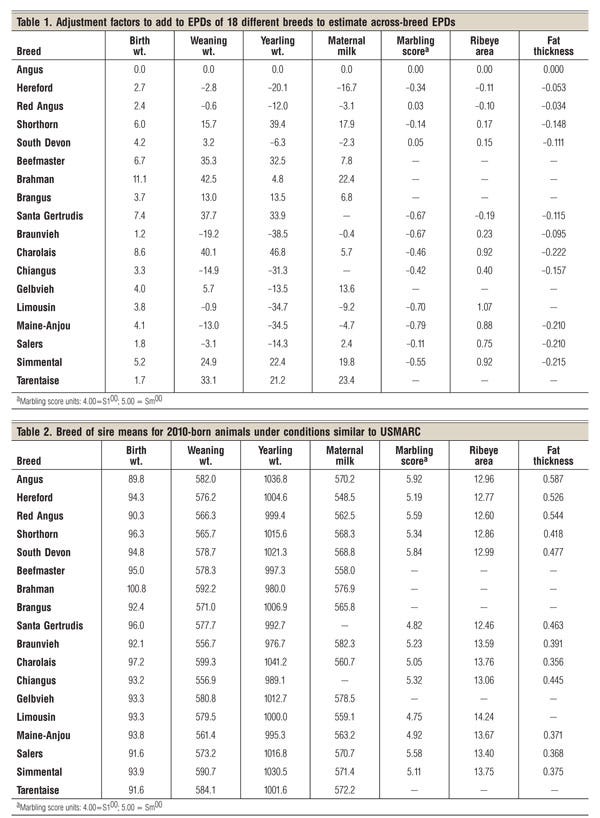Just released, the 2012 Across-Breed EPD Table provides adjustment factors that allow cattle breeders to compare the EPDs for animals from 18 different breeds for a variety of economically important traits.Download a PDF of the tables here.
May 3, 2012

The table of adjustment factors to be used to estimate across-breed expected progeny differences (AB-EPDs) for 18 breeds was released at the Beef Improvement Federation Annual Meeting in Houston, TX, on April 20 (Table 1).

Across-breed (AB) adjustment factors have been calculated for growth traits and maternal milk since 1993. Adjustment factors for carcass traits have been calculated since 2009; to be included, breeds must have carcass data in the U.S. Meat Animal Research Center (USMARC) database and report their carcass EPDs on an actual carcass basis using an age-adjusted endpoint.
Bulls of different breeds can be compared on the same EPD scale by adding the appropriate adjustment factor to the EPDs produced in the most recent genetic evaluations for each of the 18 breeds. The AB-EPDs are most useful to commercial producers purchasing bulls of more than one breed to use in crossbreeding programs. For example, in terminal crossbreeding systems, AB-EPDs can be used to identify bulls in different breeds with high growth potential or favorable carcass characteristics.
As an example, suppose a Simmental bull has a yearling weight EPD of + 52.1 lbs., and a Gelbvieh bull has a yearling weight EPD of + 84.0 lbs. The AB adjustment factors for yearling weight (Table 1) are 22.4 lbs. for Simmental and -13.5 lb for Gelbvieh. The AB-EPD is 52.1 lbs. + 22.4 lbs. = 74.5 lbs. for the Simmmental bull, and 84.0 - 13.5 = 70.5 lbs. for the Gelbvieh bull. The expected yearling weight difference when both are mated to cows of another breed (e.g., Angus) would be 74.5 lbs. – 70.5 lbs. = 4.0 lbs.
Most breed associations publish EPDs at least annually. These EPDs predict differences expected in performance of future progeny of two or more bulls within the same breed for traits including birth weight, weaning weight, yearling weight, and maternal milking ability (as reflected in progeny weaning weights).
Normally, the EPDs of bulls from different breeds can’t be compared because most breed associations compute their EPDs in separate analyses and each breed has a different base point. The AB adjustment factors allow producers to compare the EPDs for animals from different breeds for these traits; these factors reflect both the current breed difference (for animals born in 2010) and differences in the breed base point. They should only be used with EPDs current as of April 2012 because of potential changes in EPD calculations from year to year.
It’s important to note that the table factors (Table 1) don’t represent a direct comparison among the different breeds because of base differences between the breeds. They should only be used to compare the EPDs (AB-EPDs) of animals in different breeds. To reduce confusion, the means of breed of sire (i.e., when sires from two different breeds are mated to cows of a third, unrelated breed) between 2010-born animals under conditions at USMARC are presented in Table 2.
The adjustment factors in Table 1 were updated using EPDs from the most recent national cattle evaluations conducted by each of the 18 breed associations (current as of March 2012). The breed differences used to calculate the factors are based on comparisons of progeny of sires from each of these breeds in the Germplasm Evaluation Program at USMARC in Clay Center, NE.
These analyses were conducted by USMARC geneticists Larry Kuehn ([email protected] or 402-762-4352) and Mark Thallman ([email protected] or 402-762-4261).
You May Also Like

.png?width=300&auto=webp&quality=80&disable=upscale)
.png?width=300&auto=webp&quality=80&disable=upscale)
